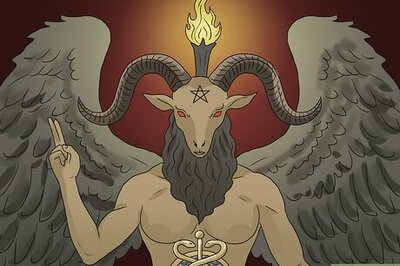
views
Alchemy Symbols for The 3 Primes
The three primes represented three philosophical aspects of human beings. In addition to producing gold, an important aim of alchemy was the philosophical and spiritual refinement of the human spirit. Important aspects of our being became associated with the substances salt, sulfur, and mercury (quicksilver): ???? (Salt): Represents the human body and non-combustibility (non-volatility). It also symbolizes the “essence” of a substance since early researchers recognized it was an essential nutrient for life. It was unknown at the time that salt was actually a compound and not a pure element. ???? (Sulfur): Represents the soul and combustibility. It’s the fluid connecting salt (body) and mercury (spirit), and a middle state between high and low. Sulfur is thought to have active or masculine energy. ☿ (Mercury or quicksilver): Represents the spirit, fusibility or volatility, and the overall life force. It symbolizes a state transcending death or the earthly realm. Mercury is thought to have passive or feminine energy. Meet the wikiHow Experts Elianne El-Amyouni is a spiritualist and doctor of philosophy with expertise in tarot, historical literature, object symbolism, spirituality, alchemy, philosophy, and Jungian analysis. Christopher Earnshaw is a Freemason with 41 years of experience with the organization. Nico Pires is a spiritual advisor, astrologer, and numerologist with over 10 years of training and experience helping clients hone their intuition.
Alchemy Symbols for The 4 Elements
The four classical elements symbolized the building blocks of all things. The elemental symbols are all represented by right-side-up or upside-down triangles and reflect the ancient Greek belief that these elements made up all matter in the world. Alchemists believed the elements had powers to create new elements and cure illnesses, and these symbols were fairly standard across alchemical practices. ???? (Air): Represents heat and wetness (water vapor was considered part of the air), the colors white and blue, the life force of all things, and blood. It is the opposite of Earth. ???? (Earth): Represents cold and dryness, physical movements, the colors green and brown, and the humor (body fluid) black bile. It is the opposite of air. ???? (Fire): Represents heat and dryness, fiery emotions like passion, love, or anger, the colors red or orange, masculinity, and the humor yellow bile. It is the opposite of water. ???? (Water): Represents cold and wetness, intuition, the color blue, femininity, and the body humor phlegm. It is the opposite of fire.
Some alchemists considered a fifth element, the aether (quintessence). In some ancient and medieval practices, the aether (or ether) was a fifth element, or quintessence, that filled the space between things and the void outside beyond the terrestrial sphere (what we know today as outer space). It was thought to be heavenly, or not of the material world. The concept of an aether outlived alchemy and was even invoked in early scientific theories about how light and gravity worked. Unlike the other elements, the aether did not have a standardized symbol. It’s often represented by a plain circle, the letters QE, or a stylized ???? symbol. In some Eastern practices, wood and metal were also considered additional elements and had their own symbols.
Alchemy Symbols for The 7 Planetary Metals
In alchemy, each of the known planets was associated with an earthly metal. Early alchemy was strongly related to astronomy and astrology, and the known planets at the time “ruled” over an associated metal. As Dr. El-Amyouni explains, “Many of the symbols that we see correspond to a metal which has a governing planet, like gold, whose governing planet is the sun. Its symbol is a circle with a dot in the middle. Mercury, the metal, and Mercury, the planet. Lead and Saturn, etc.” Uranus, Neptune, and Pluto aren’t included since these symbols were created before the invention of the telescope and the discovery of those planets. ☉ or ☼ (Gold): Associated with the sun, Sunday, and the heart. ☽ or ☾ (Silver): Associated with the moon, Monday, and the brain. ☿ (Mercury or quicksilver): Associated with mercury (the planet), Wednesday, and the lungs. The same symbol represents Mercury as one of the Three Primes. ♀ (Copper): Associated with Venus, Friday, and the kidneys. Also used as the “female” symbol. ♂ (Iron): Associated with Mars, Tuesday, and the gallbladder. Also used as the “male” symbol. ♃ (Tin): Associated with Jupiter, Thursday, and the liver. ♄ (Lead): Associated with Saturn, Saturday, and the spleen. EXPERT TIP Elianne El-Amyouni Elianne El-Amyouni Spiritualist Elianne El-Amyouni is a spiritualist, writer, reader, speaker, content creator, and doctor of philosophy based in Canada. She has expertise in tarot, historical literature, object symbolism, spirituality, alchemy, philosophy, and jungian analysis. She has a following of over 1.5 million subscribers across platforms, and shares independent content in both video and text form. Her work is informed by her personal experiences as the child of immigrants in Canada, the lessons she has been taught by spiritual mentors along the way, and her formal education. Her MA study, completed at the University of Balamand, Lebanon, involved tracing variations of symbolic tradition in Jungian dream analysis, alchemical literature, and occult poetry. Her PhD, completed at the University of Waterloo, ON, Canada, explores narratives of resistance and political identity expression in Palestinian hip-hop. She is also a columnist for the Arabic newspaper Al-Akhbar and the literary magazine Rehla. Her work has been published in a number of journals and anthologies, both literary and academic. Be it in her studies of the unconscious realm and imagination, or of the conscious world and its struggles, she is most interested in what they reveal about identity, difference, and becoming. Elianne El-Amyouni Elianne El-Amyouni Spiritualist Lead is the basest of the metals. These early proto-scientists would burn lead and then experience poisoning from the fumes because they didn't know they were toxic. They thought that lead was literally wrought with demons and therefore was an evil and base element.
Alchemy Symbols for Mundane Elements
The mundane elements make up the rest of the alchemical elements. These elements were discovered later than the planetary metals and other substances, so there isn’t as much history or philosophy behind them (although many alchemists worked with these elements and tried to find their deeper meaning). Here are the most common mundane elements used in various alchemical processes to try to turn other metals into gold.
Alchemy Symbols for Alchemical Compounds
Alchemists used symbols to describe compounds made from pure elements. Like the mundane elements, these compounds and substances didn’t have the philosophical depth of the three primes, four elements, or other base metals, and their symbols were added later. They were often used as starting points or components for alchemical experiments and transformations. These are some of the most common alchemical compound symbols (however, notation probably varied between alchemists): ???? (Acid) ???? (“Sal ammoniac” or sodium chloride) ???? (“Aqua fortis” or nitric acid) ???? (“Aqua regia” or nitro-hydrochloric acid) ???? or ???? (“Spirit of wine” or concentrated ethanol) ???? (“Amalgam” or alloys of a metal with mercury) ???? (“Cinnabar” or mercury sulfide) ???? (Distilled vinegar) ???? (“Vitriol” or sulfates) ???? (“Black sulfur” or residue from the sublimation of sulfur)
Symbols for Alchemical Processes & Time
In some practices, 12 experimental processes were aligned with the zodiac. The Magnum Opus (“Great Work”) of the alchemists was to create the philosopher’s stone from base elements. The chemical operations used in experiments were symbolized by the 12 signs of the zodiac, with each sign representing an experimental step or process. Not all alchemists believed there were 12 processes and may have used other symbols to encode their work, however. ♈︎ (Aries): Calcination ♉︎ (Taurus): Congelation ♊︎ (Gemini): Fixation (solidification) ♋︎ (Cancer): Solution ♌︎ (Leo): Digestion ♍︎ (Virgo): Distillation ♎︎ (Libra): Sublimation ♏︎ (Scorpio): Separation ♐︎ (Sagittarius): Ceration ♑︎ (Capricorn): Fermentation (putrefaction) ♒︎ (Aquarius): Multiplication ♓︎ (Pisces): Projection
Units of time were also represented by alchemical symbols. Like the alchemical processes, measuring time was an important part of alchemists’ research and experimentation. They would encode their work using these symbols representing durations of time and the seasons.
Alchemy Symbol for The Philosopher’s Stone
The philosopher’s stone was thought to purify the soul and transmute metals to gold. Creating the philosopher’s stone was the ultimate goal of the alchemists. Also called “the powder” or “the tincture,” the stone would turn base metals into precious metals like gold or silver, as well as perfect the soul by curing diseases, prolonging life, and instigating spiritual revitalization. The symbol for the philosopher’s stone is also called the “squared circle.” It symbolizes the idea that combining the four classical elements in just the right way will produce the stone. The encompassing triangle may represent the three primes as well.
More About Alchemy & Its Symbols
Alchemy is a philosophy and pseudoscience that aims to turn base metals into gold. Essentially, alchemy is an early, mythological form of chemistry that probably started with the work of ancient metallurgists who noticed that new materials could be made by heating and combining metals. There’s a spiritual aspect to alchemy, too. Alchemists strove to use their knowledge to purify the soul and procure the “philosopher’s stone,” a substance which could cure human diseases and provide eternal life. “Alchemy is a long literary tradition, just thousands of years of people writing and having a conversation with each other about certain experiments, trying to turn lead into gold, trying to create a philosopher's stone,” explains Dr. El-Amyouni. She continues, “It’s a practice that branched out at some point around the third century into a proto-chemistry where people tried to make literal gold out of metals. Other people used the language as a metaphor for the perfection of the soul. And this all happened in different parts of the world.”
Alchemists used symbols to hide their work from others and the church. When alchemists discovered a successful or promising formula, “they would encode it using symbolic language and allegory because they thought that they were preserving something very, very secret and precious. They thought that they were really going to find gold,” explains Dr. El-Amyouni. However, it wasn’t just gold thieves and competitive alchemists they had to worry about. “In the European Middle Ages, [alchemists] didn’t want the church to know what they were doing, especially the esotericists and people who were working on a ‘perfection of the soul’ situation outside of the church. This was considered very heretical,” says Dr. El-Amyouni. “It was bringing back the trauma of the Gnostics of the first century, and the church needed to have control over the spirit and spiritual life.” Essentially, Dr. El-Amyouni notes that alchemists were “using symbols to communicate with one another what they were doing in their experiments without anyone finding out. They didn't want the church to know that they were purifying their soul without the New Testament or without the church's authority.”
Alchemy helped shape our early understanding of modern chemistry. “Some of these pseudoscientists, these alchemists, were experimenting with things before anybody else was, and so much of what we have today in terms of chemical knowledge comes from these early mistakes and experiences by people who were literally just trying to make gold,” explains Dr. El-Amyouni. She continues, “When one of these alchemists, especially in the European Middle Ages, would come across what they thought was a winning formula, they would encode their experiment, the stages, and the process that they were using in symbols.” In this way, early proto-chemists described and recorded formulas, equations, substances, and reactions—the building blocks of modern chemistry.
Alchemy faded in popularity throughout the Age of Enlightenment. Freemason Christopher Earnshaw explains that “when the Royal Society was established [in 1660], the sciences were divided into different types, and one of them was chemistry. Before that, there was no chemistry; it was all alchemy… Sir Francis Bacon had written a book explaining how science should be studied and the importance of checking your results to make sure you get the same results at a later date and with different people. These new organizations used this Baconian idea, and alchemy, which was part mythology and part experimentation, was suddenly made fun of.” Eventually, “alchemy was no longer an acceptable science,” according to Earnshaw. Around the same time, rulers across Europe feared that alchemists could undermine economies by producing gold or use their skills to poison or defraud others, leading to bans and prohibitions against the practice. There’s no official “end date” for alchemy, and some academies secretly studied it as late as the 1770s. However, it continued fading into occult obscurity as time went on. Not everyone abandoned alchemy, though. “The ideas that alchemy had were very interesting to the Freemasons, and they continued the idea of alchemy by incorporating the symbolism into one of their degrees. In fact, the second degree is based on alchemical principles.”
Alchemical symbols are associated with spiritualism and magic today. According to spiritual advisor, astrologer, and numerologist Nico Pires, “Before the periodic table, alchemy symbols and planetary symbols [were used]. Once the periodic table was made and we used letters to replace the occult aspect of chemistry, we started using [alchemy symbols] like a giant metaphor. It’s a philosophy.” Pires continues, “[The symbols] are designed not just to be like the physical components [they symbolize], but also philosophical components that explain how people are refined over time. Once you remove the physical meaning of these symbols, you’re left with the philosophical meanings.” “That’s why people recognize them as magical or witch symbols,” he concludes, “but at one point, they represented literal material.”




















Comments
0 comment